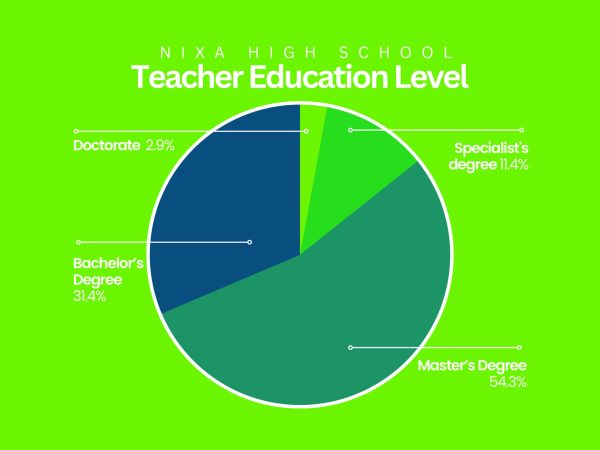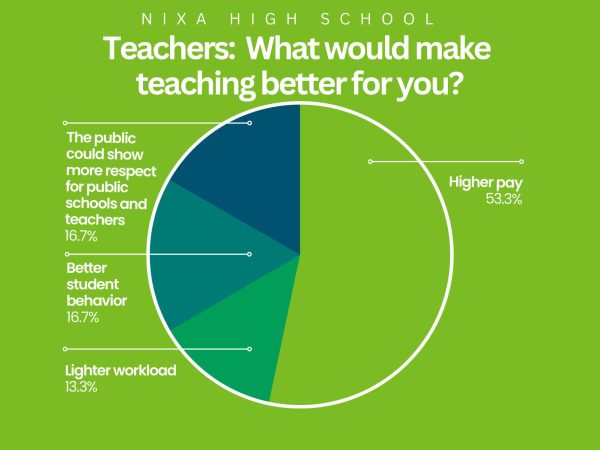The teacher shortage that has been going on for years has ramped up since COVID-19 took hold and Nixa High School has seen its own share of the shortage. As of 2023, the teacher to student ratio is 1:19 when the ideal ratio is 1:18. Some classes have more than 30 students per one teacher.
A secondary curriculum specialist for NHS teachers, Tiffany Jones said the school has been affected by the teacher shortage.
“We have a few positions that were identified as critical shortage, which allows us to hire retired teachers to be the teacher of record for the year,” Jones said. “Several districts have had to hire [substitute teachers] or non-certified teachers for empty positions; however, we are very fortunate in Nixa, and most of our teacher positions were filled by the beginning of the school year.”
The teacher hiring process has multiple intricate steps to it.
“When prospective teachers apply to Nixa, the first interview is a phone interview with our human resources department,” Jones said. “Teachers that are selected for a second round of interviews then meet with a panel of teachers and administrators and answer a variety of questions, usually including some type of performance event. The administrators then recommends a particular teacher for hire, which is then approved by the superintendent and then Nixa School Board.”
There has been a pattern of difficult teacher positions to fill over the past years.
“Special education and upper level high school math and science have been the most difficult to fill positions with the fewest number of qualified applicants,” Jones said. “So far, we have been able to fill all our positions. However, we have had a smaller pool of highly qualified applicants to select from.”
One of those newly hired teachers is English teacher Lisa Moyers, who was intrigued by Nixa’s reputation.
“Down in Georgia, I was teaching for almost 20 years at a couple different schools,” Moyers said. “Then I moved back to Missouri — I am a native Missourian. I was actually teaching middle school in two different districts at the time to get my foot in the door here in Missouri. I really missed high school teaching and when I came back to Missouri and I was closer to this area, people just kept saying, ‘Oh Nixa is a great area,’ ‘Nixa has great schools,’ but there was never anything open. I kept looking and finally this past spring an opening showed up and so I started interviewing and keeping my fingers crossed.”
Catherine Eck had a similar experience when she began teaching at Nixa two years ago.
“I came to Nixa High School after teaching for nine years at Monett High School,” Eck said. “I applied at Nixa because I had heard great things about the administration and the school district. It is really important to me to have a supportive principal and assistant principals, and Nixa has that.”
The causes of the teacher shortage vary from state and district but Moyers has a few ideas.
“I think part of it is the student behavior that teachers are tired of,” Moyers said. “Again, not necessarily saying here because I am new, but other places I would say is because of student behavior. The regulations, the work load — it is not a 7:30 to 2:30 job. Keeping the balance of your personal life versus your work life because you don’t just leave it behind. So I think that sometimes teachers who —especially new teachers just starting out — they don’t realize how much work outside of the school day is required. The class size is also a big problem too. It is very difficult to maintain large classes.”
A common blame for the teacher shortage is the teacher pay.
“I have 18 years of experience and a masters degree in history, but I don’t make nearly as much money as a teacher as I would in the corporate world,” Eck said. “I think the second biggest issue with the teacher shortage is the amount of work keeps increasing and the amount of time teachers have to do it is decreasing.”
The workload of a teacher can make a difference in a teacher’s emotional health.
“Being a teacher can be really hard because you have to be ‘on’ all the time,” Eck said. “The number of questions and decisions a teacher has to make on a daily basis, it is mentally exhausting. People only think about the grading papers and planning and that is hard, but the emotional toll the job can take on a teacher can be really hard.”
Students are also being affected from the larger classroom sizes.
“Large class sizes are just very detrimental to the individual,” Moyers said. “It is almost impossible to get to all the kids that need or even want the help. The sheer management is difficult. If you’re worth your salt at all, then it puts a guilt feeling on you because you weren’t able to help every student on the day-to-day, just because of the number of students that are in the room. I think that schools really need to be looking at what they can do to reduce the sizes of the classes if at all possible. But again, when you don’t have enough teachers that is a really big problem.”
To combat the shortage of teachers, some school districts have gone to four-day school weeks.
“I am not necessarily an advocate for four-day weeks” Moyers said. “I am not exactly sure what the true intent is for a four day week. If schools would get rid of all the ‘fluff’ that happens and get down to the brass tax of teaching kids, then a four-day week would work. But they are trying to cut it down to four days a week and still keep all of the other stuff. I think the only way a four-day week would really work is if you just become extremely focused on getting the kids what they need educationally. … Kids’ work ethic for the most part has been waning for a long time, so is cutting another day out of the school week really what they need? I don’t know if that is really a positive.”













